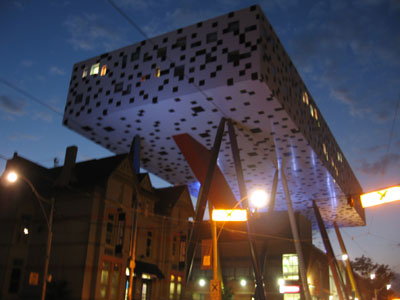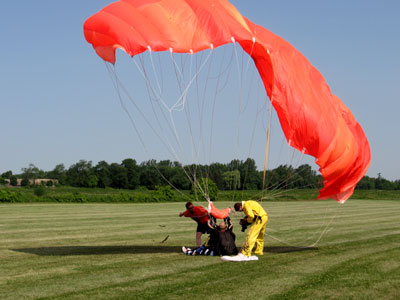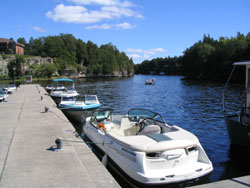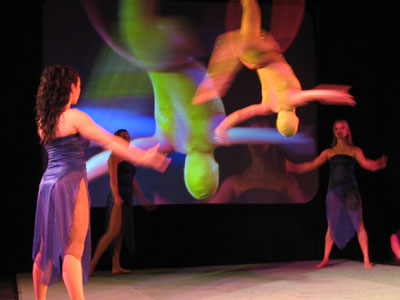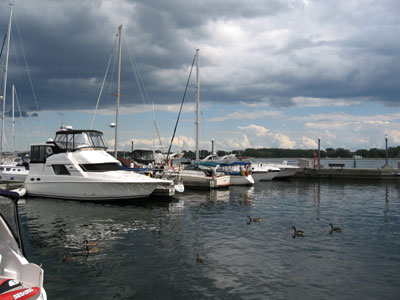The history of the Spadina area is colourful indeed. Jewish immigrants from Eastern Europe settled in the area from 1832 onwards, but major immigration got into full swing in the 1890s. Many of these poor Jewish immigrants had little language skills and began to work in low-paying jobs in the garment factories that had sprung up near Spadina.

Chinese sculptures, squeezing the CN Tower
Numerous Jewish delicatessens, tailors, cinemas, Yiddish theatres, synagogues and other political, social and cultural institutions developed in the area. Indeed, as Bruce pointed out, Spadina Avenue became the centre of the Garment District which still survives on a much smaller scale today – even today there are numerous fashion and fur stores that sell their merchandise to the public at wholesale prices. Bruce also elaborated that many of the buildings and warehouses became gradually higher, a direct result of the invention of the Otis safety elevator which made it feasible to carry out industrial manufacturing on higher level floors.

A former hotel in the Garment District
Our group then stopped at the Glen and Paul Magder Fur Store which was a pioneer in reforming Toronto’s Sunday shopping laws by staying open on Sundays, despite heavy fines. Right around here we also got to admire the former location of a theatre owned by the parents of Mary Pickford, the famous Toronto born-actress, “America’s Sweetheart” who became Hollywood’s biggest star of the Silent Era. Together with Charlie Chaplin, Douglas Fairbanks, and D.W. Griffith, Mary Pickford was a cofounder of United Artists film studios.

Vietnamese signs in Chinatown
We then walked east on Queen Street which features a whole stretch of eateries, restaurants and eclectic bars and taverns, including the Rivoli, an extremely popular bar, restaurant and pool hall. At the Horseshoe Tavern Bruce explained that many famous music acts of Toronto, including Blue Rodeo, got their start at this tavern.

The Rivoli, long a popular spot on Queen Street West
Incidentally this was also a favourite hangout for the notorious Boyd Gang, a 1950s gang of bank robbers led by Edwin Alonzo Boyd. The gang garnered a lot of media attention due to its sensational actions, including bank robberies, jail breaks, liaisons with beautiful women, gun fights and daring captures. Two of the gang members were captured and hanged for the murder of a policeman in 1952 while Edwin Boyd, by then a Canadian folk hero, was sentenced to eight life terms plus twenty seven years concurrent. He was paroled in 1966, relocated to British Columbia and died in 2002.

The Friendship House
Just steps further east is the “Friendship House”, where Russian refugees were taken in, it is also the centre of the Communist League of Toronto and the former location of the 1980s television series “Street Legal”.

The townhouses owned by two sisters who had a spat
A few steps east is a series of Victorian townhouses that, as Bruce explained, were owned by two sisters who had had a serious falling out. Although the buildings were symmetrical in appearance the sisters did their best to modify the architecture to ensure that each of their sides would look different from the other sister’s property. Bruce pointed out a couple of former vaudeville theatres, explaining that in the era before cinemas and podcasts, almost every city block had one or more of these theatres which were popular entertainment spots for the locals.

The Black Bull Tavern, dating back to 1822
At the Corner of Queen and Soho is the Black Bull, a decades old hotel and tavern that features a spacious outdoor patio. Bruce explained that in the 1800s Toronto’s city limits extended to Peter Street, and the tavern housed in this building was the last tavern on the way out of town. This was at a time when a horse and carriage ride to Niagara Falls could take two days, so a final watering hole on the outskirts of town was important.

Ecclectic shopping opportunities on Queen Street West
Another significant Toronto landmark rose up impressively in front of our eyes: Toronto’s CHUM City Building, the main studio complex of CTV Globemedia. The building houses City TV and its famous Speakers Corner video booth (which allows members of the public to voice their opinions on any topic), Cable Pulse 24, MuchMusic, Star! and the Fashion Television Channel. Its 1914 Neo-Gothic terra cotta façade make it an instantly recognizable landmark in downtown Toronto, and the news truck with the turning wheels that is built into the eastern façade make it a real icon of the downtown core.

The Neo-Gothic of the CHUM City Building
Well, our informative and entertaining Chinatown-Kensington Tour had come to an end. Bruce, with his dramatic abilities, was able to educate us and entertain us at the same time, introducing us to historically significant parts of the city that we had never seen or simply walked by without noticing.
Although a relatively young city, Toronto has a fascinating history, and Bruce Bell is just the guy to open our eyes to it.

The OCAD Building at night
